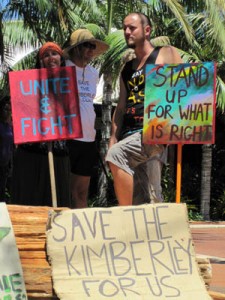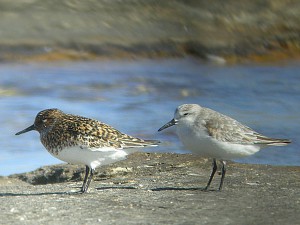Here is the text of a speech delivered by Bob Debus to a meeting of concerned citizens in the Blue Mountains. It provides an independent overview of the issues surrounding a proposal for a massive gas hub to be build on the Kimberley coast at a place called James Price Point approximately 40 km North of Broome, Western Australia.
This is a complex and long running issue that is rapidly shaping up as the biggest environmental and cultural heritage battles of our time. There is plenty of reading here but if you want some context on the issue this speech provides the in depth view that really can’t be just summed up in a few glib words.
Wentworth Falls Kimberley Meeting Speech
Bob Debus 7 May 2011
If you look at the map and some of the pamphlets from the Kimberley conservation group called Environs Kimberley and the book produced by Save The Kimberley and Murray Wilcox that we have handed out today, you’ll straight away pick up several fundamental messages.
We are talking about a large area – actually twice as big as Victoria (larger than Germany) with a population of only 40,000, half of them Indigeneous. Its 1000 kms from Kununurra to Broome.
Because of this remoteness and isolation the Kimberley has remained one of the worlds’ least degraded naturally working eco-systems. It is a global treasure but the majority of Australians have only had a slight knowledge of it. However, as community groups, environmental groups and Aboriginal organizations in the Kimberley are now saying, the region is at a crossroads.
Just at a time when national and indeed international understanding of the Kimberley is gathering some momentum, proposals for mining projects and industrial development have begun to accelerate. The largest of those projects, causing the most urgent concern, is the LNG gas plant proposed for James Price Point on the Dampier Peninsular just north of Broome. Judge Murray Wilcox is going to talk to you about the assessment processes that are under way there now.
I am going to talk to you about some other conservation decision-making that is under way in the wider Kimberley region and I hope make a context for what Murray is to say to you later.

The Broome community recently held the biggest march and rally ever held to oppose the proposal to build a massive industrial port, LNG processing plant and industrial precienct at James Price Point.
In 2008 the federal environment minister Peter Garrett initiated an investigation by the Australian Heritage Council into the national heritage values of the Kimberley. That process has been supported by his successor Tony Burke, who is likely to make a decision on the recommendations of the Heritage Council by the end of June.
The effect of national heritage listing would be to give the federal environment minister a direct role in the assessment of any development that may have an effect on identified heritage values. This is not a strong form of protection and it is not a substitute for an adequate system of national reserve on land or sea. It is not of itself a substitute for measures that would support improved management of private land. It is not a substitute for strong regional planning based on environmental values. It is, nevertheless, a very useful start for a commonwealth government looking to the national interest.
There is no time to deal here in intimate detail with the assessment published by the National Heritage Council but you can read about it on the web-site of the federal Department of Environment (http://www.environment.gov.au/heritage/ahc/national-assessments/kimberley/pubs/kimberley-combined-map-values.pdf ).
Basically, the Council has recommended national heritage listing for what it calls the west Kimberley (I would call it northwest Kimberley) from Derby 700 odd kms around the coast to Wyndham and down to Fitzroy Crossing.
[We have been showing you some images of that coast] — inundated gulfs and inlets with spectacular rocky cliffs and waterfalls; 2500 off-shore islands. People compare its aesthetic quality to the fiords in Norway: but it doesn’t just look good. I have read an assessment which says that the low level of human impact on the Kimberley waters is comparable to only two other places on earth– the Arctic and Antarctic oceans.
This marine environment boasts the southern hemisphere’s largest population of humpback whales; lots of other whale species and dugong; important populations of a number of varieties of turtle; a recently discovered new dolphin species. The fringing mangrove forests are of world significance and the fringing coral reefs are identified as one of 18 coral diversity hotspots worldwide. Both mangroves and coral have to deal with an exceptionally large tidal interval
The land of the west Kimberley is a province of mountains and dissected plateaux with a monsoonal climate – patches of ecologically critical rainforests scattered through extensive savannah woodland – Australia has 25% of the intact savannah left in the world and this is some of the best of it. Across this region recommended for national heritage listing we have 33 of Australia’s 45 classified wild rivers (but no Wild Rivers legislation).
Just north of a line running from roughly from Fitzroy Crossing to Derby you have the Napier and Oscar ranges – remnants of a limestone barrier reef from the geological era of the Devonian. Dramatic gorges occur where the Fitzroy and Lennard rivers cut through the reef (by the way, running at its height the Fitzroy could fill Sydney Harbour in a day). At the Gogo site, you have some of the best ancient fish fossils in the world.
You hear me making world comparisons with some frequency, but that’s the way it is. The Kimberley is on the one hand under threat – from potential piecemeal industrial development, from actual weed invasion and the activity of feral animals, from changed burning practices and degradation of rainforest patches from grazing. Nevertheless, as I have said, it is at present one of least disturbed regions left on earth. It has not been cultivated and it has not been logged.
Surveys have identified 72 native mammal species, nearly 300 bird species and nearly 230 amphibians and reptiles. The northern and western part of the Kimberley is the only part of Australia where there has been no mammal extinctions. It is the last refuge of a number of rare and endangered species. The most vulnerable species appear to be medium sized mammals which have rather specialized needs — like quolls and bandicoots — and birds with specialized feeding habits like the marvelous gouldian finch.
That is, wildlife that is sensitive to small changes in habitat conditions will, without careful management in the near future, disappear or at least be confined to a few peninsulas and off-shore islands.
I have not so far said anything about the indigenous cultural heritage of the Kimberley but you won’t be surprised now if I say that it is also of world importance. There are many thousands of Aboriginal art sites carrying the greatest diversity of rock art in Australia. Some of them are amongst the earliest prehistoric sites ever recorded.
There are places where songlines are still part of local life. By itself these cultural treasure could justify heritage listing for a lot of the Kimberley –in my view.
The Gwion-Gwion or Bradshaw figures [we have been showing you some] are very ancient, 30,000 years and much more. They have a quite ethereal beauty. The later Wandjina figures — great mouthless heads and associated with water stories — are much later but still up to thousands of years old. There are however contemporary artists working in the wandjina style –you may remember the stunning figure displayed in the sequence at the opening ceremony of the Sydney Olympics produced by Rhoda Roberts.
There is a lot more, old and new. A new form of old rock art was recently discovered on the Canning Stock Route. At Warmun, in the east Kimberley, artists practice in a style made famous by Rover Thomas – you can see works of his in the new exhibitions in the National Gallery. Warmun is concordant with the contemporary art movements at Yuendumu and Papunya in the central desert.
The Warmun painting is often informed by the shapes of the astounding Bungle-Bungle Mountains. I haven’t even mentioned them before now because they are protected, unlike a great many important Kimberley sites, by a national park. Unlike any other Kimberley site, they are protected by a World Heritage listing
So…the environment groups in the Kimberley all agree with the recommendations of the
National Heritage Council so far. However, they argue for the inclusion of sites of cultural and environmental significance in the flatter and more arid country to the south and the west. There is more detail in several of the pamphlets that have been handed out but I draw your attention to the argument for including the Dampier Peninsular; the whole of the Fitzroy river flood plain and not just the river itself; the rich marine environment of Roebuck Bay near Broome; Roebuck Bay and Eighty Mile Beach for their critical importance to the migration of shore birds between Australasia and east Asia. Sometimes 20, 30 or 40% of all the birds of a particular species on the entire flyway can be found standing about chatting on Eighty Mile Beach.
The Kimberley environment groups also mention the fossilized dinosaur foot prints near Broome – as I understand it paleontologists haven’t only identified foot prints of a variety of dinosaurs but they have been able to identify environments in which dinosaurs lived and actual walking tracks they might have wandered along – this is of relevance to the James Price Point proposal.
Finally the Kimberley groups argue for listing of the desert Paruku wetlands (called Lake Gregory on your map) – infused with environmental and cultural values, Aboriginal artifacts 50,000 years old – perhaps Mungo and the Willandra lakes is the best comparison.
Meanwhile, both state and commonwealth waters adjacent to the Kimberley are essentially unprotected. Although the West Australian government has recently proposed a marine park for the humpback whale calving grounds in Camden Sound, there is no equivalent whatsoever in Western Australia to the Great Barrier Reef Marine Park with its large sanctuary zones or the marine protection zones in territorial waters off south east Australia.
There are however many hundreds of mining tenements (exploration permits) granted or applied for over the land and in territorial waters right across the region.
Commonwealth planning for marine protection in territorial waters has been underway since 1998. Currently there is work going on to define areas in territorial waters that will provide a comprehensive and representative network of marine protection in each separate bioregion (beside those in southeast Australia).
The marine bioregional planning process was threatened during the last general election by Tony Abbott and it is often contested. This is why, in several of the pamphlets that have been handed out, the conservation movement in the Kimberley is asking for support in its advocacy to secure a comprehensive network of sanctuaries across the Kimberley marine environment.
If you want to make a national park on land in the Kimberley you face a problem with which I am familiar from western New South Wales. For the most part, you can’t take some crown land or a state forest and reclassify it for national park protection. If you want to get land to manage as a protected reserve you have to buy it from a willing seller. Only state governments can create national park in a state jurisdiction, although they can sometimes get some federal funding to help.
Almost all the land in the Kimberley is held by the lessees of massive cattle holdings or by the Defence Department or under Aboriginal land tenure. Indeed, although there are only around 2 ½ million hectares of formal national park (maybe 6% of the region) there is a much greater area held under Aboriginal tenure, including large areas along the northwest coast. In addition, around a third of the cattle leases are held by indigenous corporations.
The existing system of formal environment protection is inadequate. However, even a substantially built up system of still disconnected national parks could not by itself protect the most important conservation characteristic of the Kimberley – that is, its existence as a very extensive, ecologically connected, intact landscape of a sort that has long disappeared in the south of the continent. (The perspective is that the Blue Mountains world heritage area, massive by our southern standards, is 10,000 square kms, the Kimberley 425, 000 square kms)
A successful strategy to maintain or improve the conservation of the Kimberley must seek to preserve the connectivity of vegetation and waterways both at the level of individual land owners – the average pastoral station is around 230,000 hectares – and also at the regional level. All property managers will have to join in.
And this is where national heritage listing could bring significant benefits. It would support a variety of the protective and restorative measures that can be put in place to keep the country intact: the creation of more national parks using state or federal funds; the philanthropic purchase of leasehold properties for conservation purposes ; the provision of incentives to land holders to improve management of fire and weeds and to protect river banks and rain forest patches; the continued expansion of the highly successful federally-funded Aboriginal ranger program on indigenous owned and managed land.
However, you can’t make a whole of landscape conservation strategy that works if people are going to be permitted to stick gigantic industrial plants or strip mining operations in the middle of pristine environments.
I don’t believe it is realistic at all to expect that extractive industry could ever be prohibited but it is certainly reasonable to ask, as more people are now asking, that government should develop “a comprehensive conservation and development plan for the Kimberley.” It is not reasonably acceptable, from the point of view of many people, for the premier of Western Australia to refer to the Kimberley as “the new Pilbara”.
It is certainly reasonable, from the point of view of a many people, that government should, in consultation with traditional owners, create a large multiple use marine park right along the Kimberley coast. After all, that’s what was been done long ago in Queensland.
Until conservation and protection strategies of the sort I have described are actually in place there is little chance that World Heritage status for the Kimberley– such as we here in The Blue Mountains enjoy—will ever be achieved
We enjoy that status but it is manifest that the Kimberley also deserves it– and we need a lot of people to make a lot of fuss so that it may be so.










